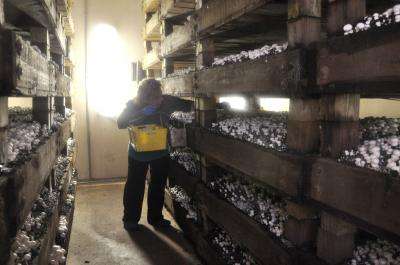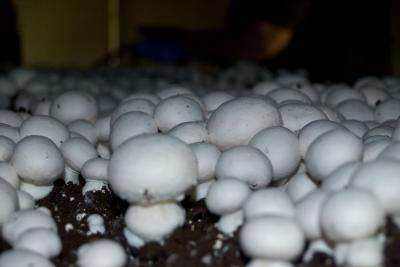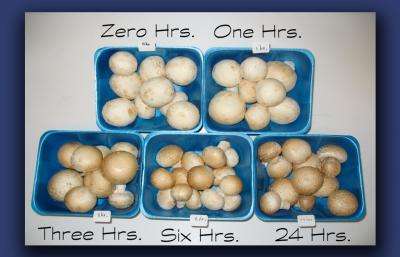Ultraviolet flashes can create vitamin D-enriched mushrooms

Quick zaps of ultraviolet light can boost the vitamin D levels in mushrooms in seconds, turning the fungi into an even healthier food, according to Penn State food scientists.
Rapid pulses of ultraviolet light increased the level of vitamin D2 in a single serving of mushrooms from practically zero to more than 100 percent of the recommended dietary allowance of 600 IUs in under a second, said Robert Beelman, professor emeritus of food science and director of the Penn State Center for Plant and Mushroom Products for Health. The treatment did not negatively affect the appearance or the taste of the mushrooms, he added.
"The scientific community is discovering that vitamin D has many more health benefits than just bone health, which it's primarily known for," said Beelman. "We know, for example, that it helps to regulate hundreds of genes."
Beelman also said that more nutritionists are investigating whether vitamin D can enhance sports performance. Researchers have already demonstrated that vitamin D supplements can improve the mobility of elderly people who, because they are vitamin D deficient, may be more at risk of falling, Beelman said.
Mushrooms are low in calories and considered a good source of vegetable proteins, potassium, fiber and essential minerals, such as selenium, according to the researchers. They are also the best dietary source of ergothioneine, an antioxidant that some researchers think is a potential new vitamin, according to Beelman.
The body naturally uses the ultraviolet light from the sun to convert cholesterol in the skin to create most of the vitamin D it needs for functions such as maintaining bone health and regulating the immune system. Consumers also receive vitamin D from some food products, such as enriched milk and orange juice.

However, as more people work inside and use sunblock when they are outside, they receive less sunlight and have more of a chance to be vitamin D deficient, according to the researchers.
The researchers, who were awarded a patent for the method, focused an ultraviolet light that can flash high energy light waves several times a second onto the surface of the mushrooms. The pulsed light was able to rapidly convert the ergosterol in the mushrooms to vitamin D2 in less than a minute. The process of converting ergosterol to vitamin D2 is similar to how humans and animals can synthesize Vitamin D3 from cholesterol in the skin.
Beelman said vitamin D2 is practically the same as vitamin D3, and it is commonly used as a Vitamin D supplement.
Beelman said the pulsed ultraviolet light method is more efficient than other methods to boost vitamin D in mushrooms because it only takes a few seconds of the treatment to significantly increase the levels. In a previous method, another group of researchers used a constant stream of ultraviolet light over several hours to increase the vitamin D levels of mushrooms. However, this constant exposure to ultraviolet lighting darkened the appearance of the mushrooms, according to Beelman.
Pulsed light did not turn white mushrooms brown or cause other discolorations, which some consumers find undesirable, said Michael Kalaras, a postdoctoral fellow in food science, who worked with Beelman.

The vitamin D remained in the mushrooms even after a week in storage.
The researchers treated both sliced and whole mushrooms. The Vitamin D levels of the sliced mushrooms were higher than the whole mushrooms, according to Kalaras.
"We are hoping that mushrooms that are treated with this technique could be a real benefit for human health by serving as an excellent source of vitamin D and especially as a source for persons who may be at risk of vitamin D deficiency," said Kalaras.
Even though it is possible to become sick from taking too much vitamin D, Beelman said that those levels are extremely high and people are unlikely to reach them accidentally.
















